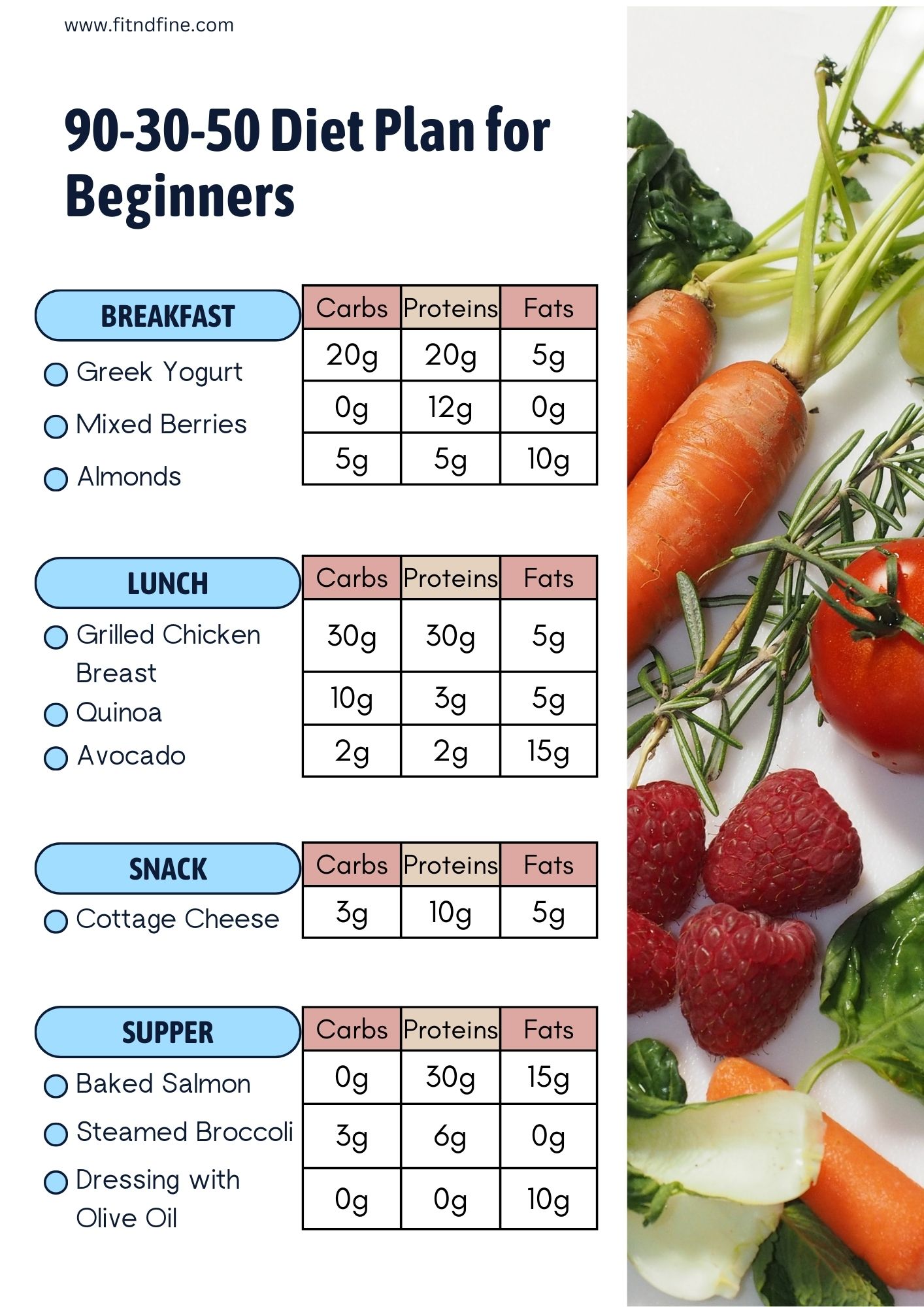The 90-30-50 diet plan for beginners is to balance macronutrients (fats, proteins, and carbohydrates) in precise amounts. It is an organized approach to nutrition. The percentages show how many calories come from each macronutrient. 30% come from fats, 50% from proteins, and 90% from carbohydrates. This ratio provides enough nutrients for energy, muscle regeneration, and metabolic function to promote overall health, weight management, and athletic performance.

Each macronutrient plays a vital role in the body. So maintaining a balance of macronutrients is necessary for both overall health and managing weight.
What is 90-30-50 diet plan for beginners?
Carbohydrates – (90% consumption):
- The body uses carbohydrates as its main energy source.
- Essential for powering daily activities, muscle contractions, and cognitive function.
- Maintaining steady blood sugar levels, reducing energy dips, and controlling appetite and so cravings are all made possible by consuming carbohydrates in moderation.
- E.g.- Grains, legumes, fruits, vegetables, and starchy meals like rice and potatoes are sources of carbohydrates.
Proteins – (50% consumption):
- Help in the synthesis of hormones, the activity of enzymes, and the maintenance and repair of tissues, such as muscles, bones, and organs.
- Promote immunological response.
- Consuming enough protein increases satiety, aids in weight loss by speeding up metabolism, and preserves muscle mass.
- E.g.- Tofu, dairy products, fish, meat, chicken, eggs, lentils, and nuts are common sources of protein.
Fats – (30% consumption):
- Required for hormone production and the absorption of fat-soluble vitamins (A, D, E, and K).
- Offer a focused energy supply and aid in controlling body temperature.
- Incorporating heart-healthy fats into the diet helps lower inflammation, strengthen brain function, and strengthen the heart.
- E.g.- Avocados, almonds, seeds, coconut oil, olive oil, and fatty seafood are good sources of fats.
NOTE:
These percentages offer a foundation for maintaining different metabolic processes in the body, supporting overall health, and balancing macronutrients in the diet. Based on personal needs, exercise levels, and health objectives, adjustments can be made.

Why 90-30-50 diet plan for beginners?
- Provide optimal macronutrient balance.
- Maintain sustained energy levels.
- Promotes muscle maintenance and growth.
- Aids in weight management.
- Improve metabolic health.
- Enhance athletic performance.
- Normalize heart health.
- Drives education and awareness.
Remember:
Through a balanced approach to diet, people can gain these benefits and support their general health, fitness objectives, and long-term well-being.
Click here to know more about the plan.
How to follow 90-30-50 diet plan for beginners?

(A sample diet plan attached below.)
A. Following Instructions:
- Calculate Your Daily Calorie Needs – Determine your daily calorie needs by putting several parameters such as age, gender, height, weight, and activity level into the formula.
- Assign Macronutrients – Using the 90-50-30 ratios as a guide, make sure you eat 30 grams of fats, 50 grams of protein and 90 grams of carbohydrates.
- Organize Your Meals – Distribute these macronutrients among your daily meals and snacks.
- Track Your consumption – Monitor your daily consumption, use a food journal or a nutrition tracking software like MyFitnessPal.
- Maintain Hydration – Try to have eight glasses or more of water each day. Drinking enough water aids in digestion and metabolism in general.
B. Implementing Guidance:
- Select High-Quality Protein Sources – Incorporate plant-based protein sources, dairy, eggs, fish, lean meats, and legumes.
- Choose Healthful Fats – Give priority to unsaturated fats found in foods like olive oil, avocados, almonds, and seeds.
- Take Low-Glycemic Carbohydrates – Carry consistent energy levels by choosing fruits, whole grains, and vegetables with a low glycemic index.
- Set up your meals – Plan your meals in advance to steer clear of harmful options at the last minute.
- Adjust portions as Needed – Everybody has a unique body. Modify your food selections or portion sizes if you are having trouble adhering to the precise ratios.
C. Efficient Monitoring:
- Use a Food Scale – Weigh your food to determine portion sizes precisely, which guarantees proper tracking of macronutrients.
- Read Food Labels – Determine the amount of protein, fat, and carbohydrates in packaged goods, look up the nutrition data.
- Be consistent – Record your daily food consumption in a consistent manner.
- Try Reliable sources – Make use of reputable databases, such as the USDA National Nutrient Database, or the dietary data offered by the applications.
- Track your progress – Keep tabs on your daily consumption with an app or a food journal. Examine your consumption of macronutrients on a regular basis to make sure you are on track.
Extra Advice:
- Keep Nutritious Snacks Available.
- Acquire knowledge about the macronutrient makeup of various foods.
- Incorporate Variety by change up your meals to stave off monotony.
- Ask for Help by joining online communities or find a buddy who is following a similar plan.
- When dining out, choose dishes that fit your macronutrient goals. Do not be afraid to ask for modifications.

By integrating these strategies into your routine, you can effectively adhere to the 90-30-50 diet plan for beginners and maintain a balanced and healthy diet.
